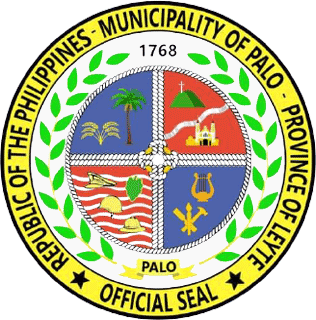
Palo seal is quartered by a white cross, a symbol of Catholicism and Palo as the seat of the Diocese.
Quarter 1 is in blue with six palay stalks representing the six major districts Sta Cruz, Cavite East, Cavite West, Arado, Buri and Luntad. A coconut tree with two bamboo containers attached to its racemes symbolizing one export product which is the aged liquor from the coconut sap now popularly known as “Bahalina.” Both palay and coconut tree represent the main crop of Palo which is an agricultural town.
Quarter 2 is in red with a lyre symbolizing the fine arts which Palo excels. There is a two-peak mountain drawn in an Italian heraldic way symbolizing the Guinhangdan Hill or Hill 522. Below the two-peak mountain is a silver ribbon which is the Bangon River.
Quarter 3 is likewise in red with yellow headgears: the famous cap of Gen. Douglas Mac Arthur, Helmet of Gen. Carlos Romulo and other American Officers and the tropical helmet of President Sergio Osmeña of the Philippines which all represent the landing of the US Armed Forces of Liberation on Oct. 20, 1944 at Red Beach, Palo to reestablish democracy in the country. In addition, a Taro leaf symbol of the 24th Infantry Division of the US Army is integrated to the official seal pursuant to Resolution No. 58, series of 1974 of this municipality .
Quarter 4 is in blue with brown and white ropes in square knot stretched between two islands, one with a coconut tree, the opposite with a tall tree (El Palo Alto ). This is the symbol of the twin City Affiliation of Palo, Leyte Philippines and Palo Alto California USA established on January 10, 1963.
Around the quarters are 21 laurel leaves on two yellow laurel branches grouped with a ribbon with incription “PALO”. This represents the 21 (before) barrios of Palo.
1768 is the year when Palo became an organized municipality.
1968 200th year of the Municipality of Palo and it is the year when the Official Seal of Palo was adopted by the Municipal Council of Palo (1968-1971)
Note: The ordinance institutionalizing the Official Seal is already approved on first and second reading. It is scheduled
____________________________________________
Municipal Resolution No. 58, series of of 1974 “ Resolution to include the Taro Leaf on the Official Seal of the Municipality of Palo.”
The tree is California Historical Landmark No. 2 (number 1 is the Old Customhouse in Monterey). It is recognized by the National Arborist Association and International Society of Arboriculture for its historical significance as “a campsite for the Portola Expedition Party of 1769”; being frequented by the Costanoan/Ohlone Indians; and for its use as a sighting tree by surveyors plotting out El Camino Real. The tree is depicted on the city of Palo Alto’s official seal and on the seal of Stanford University. It is the origin of the city’s name.

